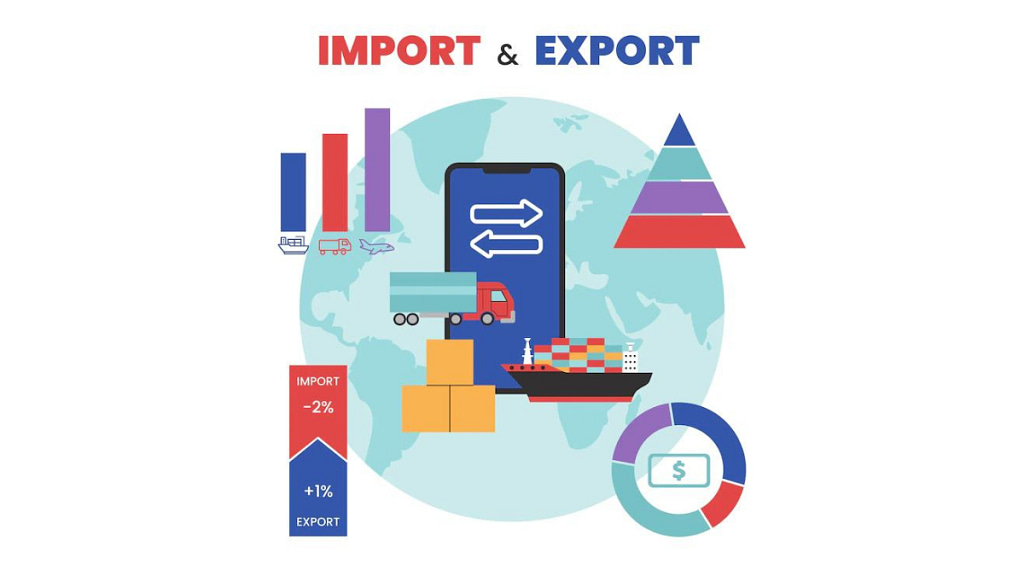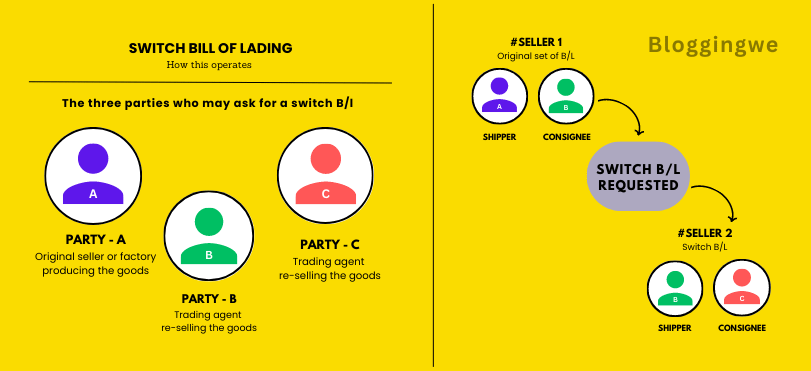
Definition: Switch Bill of Lading in Export-import. In international trade, a bill of lading (B/L) is a legal document issued by a carrier or its agent that acknowledges the receipt of goods for shipment. The B/L serves as evidence of the contract of carriage, receipt of the goods, and title to the goods.
A switch bill of lading is a type of bill of lading issued to replace the original bill of lading after it has been published. This is typically done to transfer the title of the goods to a new party.
Switch bills of lading are commonly used in international trade when the original buyer/seller of the goods decides to transfer the title to a new party before the goods arrive at their destination.
For example, a buyer may sell the goods to a new buyer before the goods arrive at the port of destination, and in this case, a switch bill of lading would be issued to reflect the change in ownership of the goods.
However, it is important to note that switching bills of lading can be controversial, and they are not always accepted by all parties involved in a transaction. Some buyers, for example, may require the original bill of lading in order to take possession of the goods, and some carriers may refuse to issue a switch bill of lading for various reasons.
If you are involved in an international trade transaction and are considering using a switch bill of lading, it is important to consult with a knowledgeable and experienced trade professional to ensure that you are complying with all relevant laws and regulations and that you are taking appropriate steps to protect your interests.
Table of Contents
Switch Bill of Lading in Export-import
Purpose of Using Switch Bill of Lading
The purpose of using a switch bill of lading in international trade is to transfer the title of goods from the original buyer/seller to a new party. This may happen for various reasons, such as a change in the buyer or a change in the terms of the sale.
Some of the common purposes of using a switch bill of lading include:
- Change in the buyer: The original buyer of the goods may decide to sell or transfer the goods to a new buyer before the goods arrive at the destination port. In this case, the original buyer can request a switch bill of lading to transfer the title of the goods to the new buyer.
- Change in the terms of the sale: The terms of the sale may change after the original bill of lading has been issued. For example, the seller may agree to extend credit terms to the buyer, or the buyer may request changes to the delivery terms. In such cases, a switch bill of lading may be used to reflect the changes in the terms of the sale.
- Confidentiality: In some cases, the original buyer may not want the seller to know the identity of the ultimate buyer of the goods. In such cases, a switch bill of lading can be used to transfer the title of the goods to a third party, who will then take possession of the goods and deliver them to the ultimate buyer.
It is important to note that the use of a switch bill of lading can be controversial, and it is not always accepted by all parties involved in a transaction. Therefore, it is important to consult with an experienced trade professional and comply with all relevant laws and regulations to ensure that the switch bill of lading is used appropriately and effectively.
Switch Bill of Lading in Export-import
Modifications to BL
A bill of lading (B/L) is a legal document that serves as evidence of the contract of carriage, receipt of the goods, and title to the goods. Once a bill of lading has been issued, it is generally not recommended to make modifications to the document.
However, there may be cases where modifications are necessary due to errors or changes in the shipment details. In such cases, the carrier may agree to issue a corrected bill of lading or a “re-stamped” bill of lading that shows the changes made to the original document.
It is important to note that any modifications to a bill of lading should be made carefully and with the consent of all parties involved in the transaction. Changes to the bill of lading can affect the transfer of title and may impact the liability of the parties involved. Therefore, it is important to consult with a knowledgeable trade professional and comply with all relevant laws and regulations to ensure that any modifications to the bill of lading are made correctly and legally.
In summary, while modifications to a bill of lading are not recommended, in some cases they may be necessary. It is important to handle any modifications with care and to consult with a trade professional to ensure that the changes are made correctly and in compliance with all relevant laws and regulations.
Switch Bill of Lading in Export-import
Procedure to Issue Switch Bill of Lading
The issuance of a switch bill of lading in international trade involves a specific procedure to ensure that the transfer of title is completed correctly and legally. Here is a general procedure for issuing a switch bill of lading:
- Agreement between parties: The parties involved in the transaction must agree to the use of a switch bill of lading and the terms of the transfer of title.
- Request for switch bill of lading: The original buyer of the goods should submit a written request to the carrier or its agent to issue a switch bill of lading.
- Verification of original bill of lading: The carrier or its agent will verify the authenticity of the original bill of lading and the transfer of title from the original seller to the original buyer.
- Issuance of switch bill of lading: Once the verification process is complete, the carrier or its agent will issue a switch bill of lading that reflects the change in ownership of the goods.
- Delivery of switch bill of lading: The switch bill of lading should be delivered to the new buyer of the goods, who will then take possession of the goods at the destination port.
It is important to note that the use of a switch bill of lading can be controversial, and it is not always accepted by all parties involved in a transaction.
Therefore, it is important to consult with an experienced trade professional and comply with all relevant laws and regulations to ensure that the switch bill of lading is used appropriately and effectively.
Switch Bill of Lading in Export-import
Switch Bill of Lading Example

Here is an example of a switch bill of lading:
Original Bill of Lading
- Shipper: ABC Corporation
- Consignee: XYZ Company
- Notify Party: John Smith
- Vessel: MV ABC
- Port of Loading: Nhava seva, India
- Port of Discharge: Los Angeles, USA
- Description of Goods: 1000 boxes of electronics
- Date of Issue: January 1, 2023
Switch Bill of Lading ( Switch Bill of Lading in Export-import )
- Shipper: ABC Corporation
- Consignee: John Smith
- Notify Party: XYZ Company
- Vessel: MV ABC
- Port of Loading: Nhava seva, India
- Port of Discharge: Los Angeles, USA
- Description of Goods: 1000 boxes of electronics
- Date of Issue: January 10, 2023
In this example, the original bill of lading showed that the goods were being shipped from ABC Corporation to XYZ Company, with John Smith as the notifying party. However, after the original bill of lading was issued, the buyer of the goods changed to John Smith. Therefore, a switch bill of lading was issued to transfer the title of the goods from XYZ Company to John Smith.
It is important to note that the specific details of a switch bill of lading may vary depending on the terms of the transaction and the parties involved. Therefore, it is important to consult with a knowledgeable trade professional and comply with all relevant laws and regulations when using a switch bill of lading.
Boost Your Export-Import Business! Unlocking the Mystery. – Bloggingwe
Oxybiz Global – An Export Import Company
conclusion
In conclusion, a switch bill of lading is a document that is used in international trade to transfer the ownership of goods from the original buyer to a new buyer. The use of a switch bill of lading can be controversial and is not always accepted by all parties involved in a transaction.
Therefore, it is important to consult with an experienced trade professional and comply with all relevant laws and regulations to ensure that the switch bill of lading is used appropriately and effectively.
Any modifications to a bill of lading should be made carefully and with the consent of all parties involved in the transaction, and it is important to handle any modifications with care to ensure that the changes are made correctly and in compliance with all relevant laws and regulations.
Switch Bill of Lading in Export-import
Pingback: Boost Your Export-Import Business! Unlocking the Mystery. - Bloggingwe